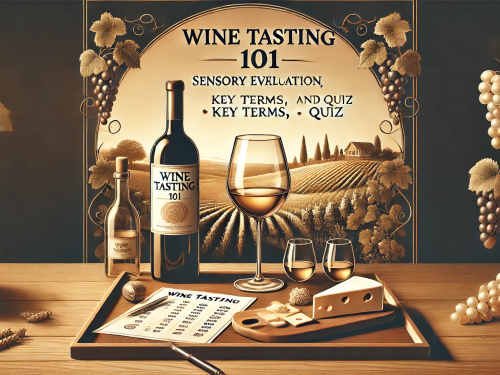Wine Tasting 101: Sensory Evaluation, Key Terms, and Quiz
/
8 November 2024 /
Glossary of Key Terms
- Acidity: The tart, sour, or mouthwatering sensation in wine, primarily caused by tartaric acid. Provides freshness and balance.
- Aroma: The smell of wine, often used interchangeably with "bouquet." It reveals the grape variety, winemaking techniques, and aging.
- Balance: Harmony between the components of wine: sweetness, acidity, tannin, alcohol, and flavor. A well-balanced wine has no single element dominating.
- Body: The weight and fullness of wine in the mouth. It ranges from light-bodied (like skim milk) to full-bodied (like heavy cream).
- Bouquet: The complex aromas that develop in wine as it ages, often including notes beyond the primary fruit aromas.
- Clarity: The visual appearance of the wine, indicating whether it is clear, hazy, or cloudy.
- Complexity: The presence of multiple layers of aromas and flavors, making the wine interesting and engaging to drink.
- Dry: A wine with little or no residual sugar, meaning it is not sweet.
- Finish: The lingering aftertaste of wine after swallowing. A long finish is generally considered desirable.
- Flavor: The taste of the wine on the palate, influenced by the grape variety, terroir, and winemaking process.
- Intensity: The strength and concentration of aromas, flavors, or color in the wine.
- Off-Dry: A wine with a slight sweetness, containing a perceivable level of residual sugar.
- Oak: The flavor imparted to wine by aging in oak barrels, often adding notes of vanilla, spice, toast, or cedar.
- Sweetness: The level of sugar in wine, ranging from dry to off-dry to sweet.
- Tannin: A bitter, astringent compound found in grape skins, stems, and seeds. Contributes to the structure, texture, and aging potential of red wines, creating a drying sensation in the mouth.
Short-Answer Quiz
- What are the three primary sensory aspects used to evaluate a wine?
- Explain the difference between "aroma" and "bouquet" in wine terminology.
- Describe the role of "tannins" in red wine and their effect on the palate.
- What does "balance" refer to in the context of wine tasting, and why is it important?
- How does the "finish" of a wine contribute to the overall tasting experience?
- Provide three descriptive terms for the "color" of white wines, ranging from pale to more intense.
- Name three "fruity" aromas commonly found in red wines.
- Give an example of a "floral" aroma and an "earthy" aroma that you might detect in a wine.
- What does "off-dry" indicate in terms of the sweetness level of a wine?
- How does the "body" of a wine affect its perceived texture in the mouth?
Short-Answer Quiz Answer Key
- The three primary sensory aspects used to evaluate wine are appearance (visual assessment), aroma (smell), and taste (palate).
- "Aroma" refers to the initial smells of the wine, primarily derived from the grape varietal. "Bouquet" develops with aging, encompassing more complex aromas resulting from fermentation and maturation.
- Tannins, found in grape skins, stems, and seeds, give red wine structure and a drying, astringent sensation on the palate. They contribute to the wine's aging potential.
- Balance in wine means that sweetness, acidity, tannin, alcohol, and flavor are in harmony. No single element overwhelms the others, leading to a pleasurable tasting experience.
- The finish is the lingering aftertaste of the wine. A longer finish indicates complexity and quality, leaving a lasting impression on the palate.
- Descriptive terms for white wine color: lemon yellow (pale), golden yellow (medium intensity), amber (intense).
- Fruity aromas in red wine: blackcurrant, blackberry, raspberry.
- Floral aroma: rose. Earthy aroma: mushroom.
- "Off-dry" signifies a wine with a touch of sweetness, meaning it has a perceivable but not dominant level of residual sugar.
- Body describes the weight and fullness of wine in the mouth. A light-bodied wine feels delicate, a medium-bodied wine has moderate weight, and a full-bodied wine feels rich and dense.
Essay Questions
- Explain how the concept of "terroir" influences the aroma and flavor profile of a wine.
- Discuss the factors that contribute to the "complexity" of a wine and its importance in sensory evaluation.
- Describe the differences in tasting and describing white wines compared to red wines, highlighting key characteristics to consider.
- Analyze the relationship between the "acidity" and "sweetness" of a wine and their role in achieving balance.
- Elaborate on the role of oak aging in winemaking, considering its influence on aromas, flavors, and texture.

